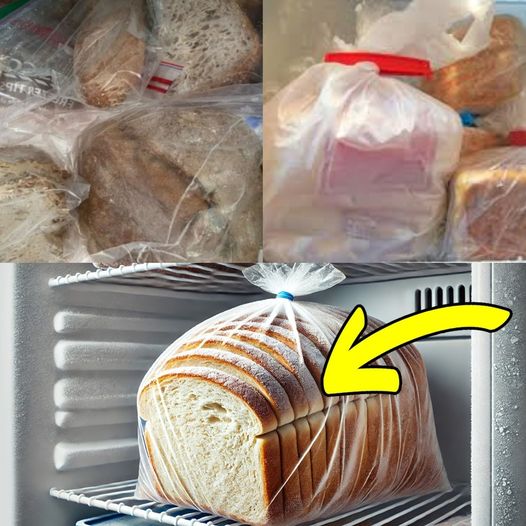ADVERTISEMENT
The Key Benefits of Freezing Your Bread
1. Prolongs Freshness
Bread is best enjoyed when it’s soft and fresh, but that doesn’t always happen, especially if you buy or bake in bulk. Freezing bread helps preserve its moisture and prevents it from drying out. By freezing it, you extend the life of the bread, allowing you to enjoy it at your convenience without worrying about it becoming stale.
- How it works: Freezing halts the growth of mold and prevents the bread from becoming hard or stale. When you thaw it, the bread retains its original texture, as if it were freshly baked.
2. Saves Money
Freezing bread allows you to buy in bulk or bake larger batches, saving you money in the long run. Instead of purchasing a new loaf every few days, you can freeze multiple loaves and take them out as needed. This is particularly helpful if you find great sales on bread or if you have leftover bread that you don’t want to waste.
- How it works: Bread can be expensive, especially specialty loaves or artisan varieties. By freezing extra loaves, you can stock up on your favorites without worrying about them going bad before you get the chance to enjoy them.
3. Reduces Food Waste
Many of us throw away bread when it becomes stale or moldy, but freezing it helps reduce waste. When you freeze bread right away, you prevent the need to discard uneaten loaves. Instead, you can enjoy fresh bread at any time without the fear of throwing away food.
- How it works: Simply slice the loaf before freezing it, so you can pull out only the number of slices you need, minimizing waste and avoiding spoilage.
4. Convenience and Time-Saving
Having frozen bread on hand is incredibly convenient, especially on busy mornings or when you’re running low on time for meal prep. Freezing bread allows you to always have a fresh loaf available, even if you haven’t had time to go to the store. You can defrost it quickly or toast it straight from the freezer for a fast and satisfying breakfast or snack.
- How it works: Whether you prefer bread for a sandwich, toast, or as a side with dinner, freezing gives you quick access to your favorite bread without needing to buy it fresh each time.
5. Maintains Nutritional Value
Freezing bread can help retain its nutritional value over time. While bread may lose some of its vitamins and nutrients if stored improperly or left out for too long, freezing can slow down this process and help preserve the bread’s nutritional content.
- How it works: Freezing locks in the nutrients, allowing you to enjoy your bread at its healthiest, even days or weeks after purchase.
6. Perfect for Special Diets
If you’re following a specific dietary plan, such as gluten-free, low-carb, or vegan, freezing bread can be a real game-changer. Specialty breads can often be more expensive, and they may not be available in stores as frequently. Freezing these loaves allows you to stock up and enjoy your bread whenever you want, without worrying about it expiring quickly.
- How it works: By freezing bread that suits your dietary needs, you ensure you always have access to bread that aligns with your health goals, without needing to compromise on freshness.
How to Freeze Bread the Right Way
Freezing bread is simple, but there are a few tips to ensure that it stays as fresh as possible:
1. Slice Before Freezing
If you freeze a whole loaf, you may find it inconvenient to thaw and cut slices when you only need a few. Instead, slice your bread before freezing it so you can take out exactly the amount you need. This way, each slice is ready to toast or eat without the hassle.
2. Wrap It Properly
To prevent freezer burn and maintain the quality of your bread, it’s important to wrap it properly. Wrap the entire loaf or individual slices in plastic wrap, aluminum foil, or freezer bags. Be sure to remove as much air as possible to prevent moisture loss and preserve the bread’s texture.
3. Label and Date
To keep track of how long your bread has been frozen, always label the package with the date of freezing. While bread can last up to three months in the freezer, labeling ensures that you use it within the ideal timeframe.
4. Thawing Your Bread
When you’re ready to enjoy your frozen bread, there are a few ways to thaw it:
- Room temperature: Leave the bread on the counter for a few hours to thaw completely.
- Toaster or Oven: If you need bread quickly, you can toast frozen slices directly or heat the whole loaf in the oven. Place it in a preheated oven at 350°F (175°C) for about 10 minutes to refresh it.
5. Avoid Refreezing
Once you’ve thawed your bread, it’s best not to refreeze it. Refreezing can affect the texture and quality of the bread, so only freeze it once for optimal freshness.
Conclusion
Freezing your bread is a simple yet highly effective way to keep it fresh, soft, and delicious for longer. With the ability to extend shelf life, save money, reduce food waste, and provide convenience, freezing bread is a practical solution for any household. Whether you buy bread in bulk, bake at home, or simply want to keep bread on hand for busy days, the benefits are clear.
So, next time you bring home a fresh loaf or bake a batch, don’t hesitate to pop it in the freezer. With just a few easy steps, you’ll always have access to fresh, soft, and tasty bread, whenever you need it.
ADVERTISEMENT
ADVERTISEMENT
